 |
 |
With no warning the attacking planes came into sight over pearl harbor. At 7:55 AM, December 7, 1941 the first target was hit and by 9:45 AM it was all over. Behind them the Japanese left devastation as their aircraft carriers headed home to Japan. Over 2400 people died, hundreds of planes were destroyed, and a fleet containing eight battleships was ruined. With a single act, Japan woke America to the horrible realities of war. The debate that had divided Americans since the German defeat of France was decided, America would go to war. President Roosevelt received word of the attack on a Sunday afternoon and stated he would ask congress to declare war on Japan. On Monday the declaration of war was signed and one day later, Germany, Italy, and Japan declared war on the US.
The following narrative of the Pearl Harbor attack has been compiled from official US Navy files, Congressional records and other official Government sources.
SHIPS IN THE HARBOR AND HARBOR FACILITIES
In December 1941, the entrance to Pearl Harbor was protected by two nets: An outer anti-torpedo net with boat booms consisting of cross spikes to prevent surface craft from entering the harbor and an inner anti-torpedo net without boat booms. The nets served to guard the harbor against submarine as well as torpedo attacks. The channel at the entrance was 400-feet wide and 41 to 50 feet deep. Since the extended depth of the seaward net was 30 feet, the inner net was suspended 15 feet to afford a total coverage of 45 feet.
Many installations in the harbor at the time of the attack were less than three years old. The major installations included: a battleship dock built in 1928; a battleship dock under construction; one floating dry dock, 18,000 tons; a large repair basin containing industrial installations capable of repairing anything afloat; a fuel depot and two tank farms above ground; a submarine base; a section base (inshore patrol and harbor entrance control post); the 14th Naval District headquarters and the Naval Station Ford Island.
Ships present in the harbor the morning of the attack and their location were as follows: Eight of the Pacific Fleet nine battleships, 29,000 to 33,000 tons each: NEVADA, ARIZONA, WEST VIRGINIA, TENNESSEE, OKLAHOMA, MARYLAND and CALIFORNIA were moored in Battleship Row along the southwest shore of Ford Island. The PENNSYLVANIA, was in dry-dock 1 in the Navy Yard.
Two heavy cruisers, NEW ORLEANS and San Francisco, both 10,000 tons, were in the Navy Yard repair basin Four light cruisers, 10,000 tons, were berthed as follows: ST. Louis, HONOLULU, Helena at Navy Yard docks, and Phoenix moored 0n the Northwest side of Ford Island.
Two light cruisers, 7,000 tons, Raleigh and Detroit, were moored on the northwest side of Ford Island.
Twenty nine destroyers, all but three completed after 1933, were moored to the north and west of Ford Island.
There were five submarines, four of which were tied up at the submarine base and the fifth at 1010 dock in the Navy Yard (so named because of its length, 1,010 feet).
One gunboat was tied up at the Navy Yard dock. Nine minelayers (eight of which were converted flush-deck destroyers) moored in middle loch and at the Navy Yard docks.
Eleven minesweepers (five of which were converted flush-deck destroyers) moored at middle loch and at the Navy Yard docks.
Twenty-three fleet auxiliaries; repair ships, oilers, tenders, store ships and tugs were located at berths throughout the harbor.
Fortunately there were no carriers in the harbor. There were three carriers assigned to the fleet: the ENTERPRISE, which was 375 miles west of Pearl Harbor, enroute to Hawaii from Wake Island; the LEXINGTON was 460 miles southwest of Midway, enroute from Pearl Harbor to to ferry a Marine Corps bomber squadron to Midway; the SARATOGA was enroute from the west coast to Hawaii.
All ships in Pearl Harbor were in readiness condition: three at the time of the attack(i.e., a quarter of the anti-aircraft batteries and necessary control stations manned and ready ammunition at the guns). Ships in that condition of readiness were required to be able to get underway within 12 hours.
NAVY RADAR EQUIPMENT
Radar was new to the US Fleet in 1941. Of the ships in Pearl Harbor only the battleships PENNSYLVANIA, CALIFORNIA, WEST VIRGINIA and seaplane tender CURTISS were equipped with ship search radar. Due to the height of the mountains surrounding the harbor, this equipment was not in operation when the attack began. Within 15 minutes of the beginning of the attack, the PENNSYLVANIA and CURTISS had their equipment in operation. Both had negative results.
FIRST JAPANESE CONTACT
The destroyer WARD conducted an anti-submarine patrol just outside the harbor entrance the night of December 6th and the early morning of December 7th. At 2 a. m. the morning of the 7th, the minesweepers CONDOR and CROSSBILL stood out of Pearl Harbor and began sweeping operations in the same area. At 3:45 a.m., the CONDOR operating about 1 3/4 miles from the harbor entrance, sighted a submarine periscope about 100 feet away. The periscope disappeared immediately, but the CONDOR notified the WARD of the sighting by visual signal. The Ward's crew immediately went to general quarters and the ship began an extensive search for the unidentified craft.
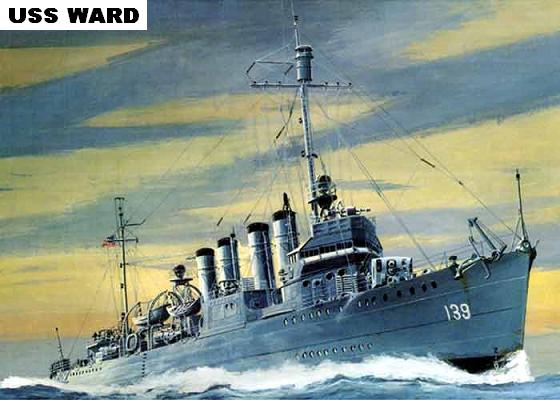
The submarine was spotted by the WARD at 6:40 a.m..The ship closed on the sub immediately and commenced an attack with her guns and depth charges at 6:45 a.m.. The second salvo from the guns made a direct hit on the craft's conning tower and the vessel sank. A large oil bubble appeared on the surface at 7:06 a. m. and the Ward notified the 14th Naval District Duty Officer of the contact. The following message was received at District Headquarters at 7:12 a.m.:
"WE HAVE ATTACKED, FIRED UPON, AND DROPPED DEPTH CHARGES UPON A SUBMARINE OPERATING IN THE DEFENSIVE SEA AREA."
The information was reported to the Pacific Fleet Duty Officer at 7:15 a.m.. This was the first word at Pearl Harbor that unidentified submarines were operating in the defensive sea area.
When the Ward's report was received, the ready-duty destroyer MONAGHAN was ordered to sea to verify the report and to relay details to the Fleet Duty Officer. She was the first ship underway after the attack began, leaving her berth 8:27. At 8:43 she rammed and sank a Japanese midget submarine in the harbor north of Ford Island. She then stood out of the harbor.
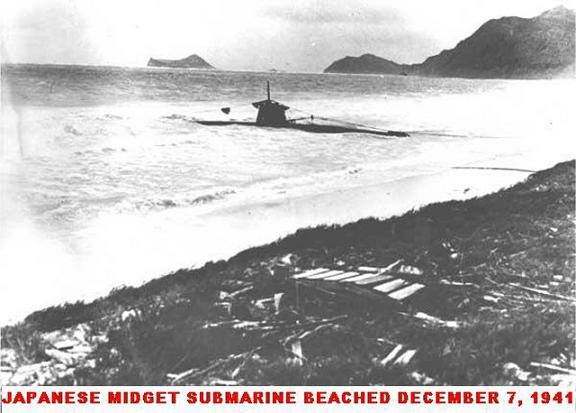
THE ATTACK
At 7:55 a.m. Pearl Harbor time the Pearl Harbor signal tower telephoned the Pacific Fleet Commander:
ENEMY AIR RAID-NOT DRILL!
At nearly the same time Japanese torpedo planes began attacking the ships on Battleship Row. For almost two hours, until 9:45 a. m., Pearl Harbor was under attack.
PHASES OF THE ATTACK
The attack was carried out in five phases: (1) 7:55 to 8:25 Torpedo plane and dive bomber attacks; (2) 8:25 to 8:40 Lull in attack; (3) 8:40 to 9:15 Horizontal bomber attacks; (4) 9:15 to 9:45: Dive bomber attacks; (5) Completion of raid.
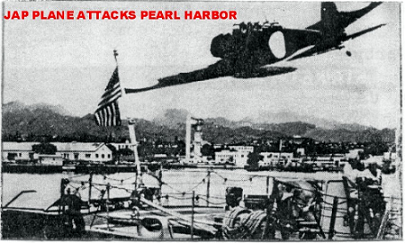
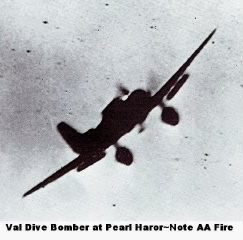
The only attack on Ford Island took place in the opening minutes of the raid. Seventy patrol boats, float planes and carrier type scout bombers on the field caught fire, resulting in 33 being destroyed or severely damaged.
The major damage in the first wave was done by torpedo planes. They launched their torpedoes from extremely low altitude, as low as 50 to 100 feet, and the harbor's shallow water did not prevent the successful execution of these attacks since the torpedoes had been specially fitted with wooden fins to compensate for water depth.
There were four separate attacks in phase one, the major one being made by 12 planes coming in over the southwest corner of the tank farm in the vicinity of Merry's Point Landing. During the first wave, all the outboard ships in Battleship Row received torpedo hits.
The OKLAHOMA was hit by three torpedoes during the second attack of this phase. She began listing rapidly.


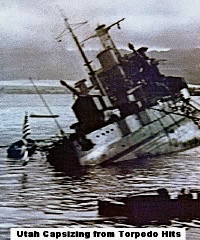

The UTAH recently returned to Pearl Harbor from serving as a target for practice aerial bombardment. When the Japanese hit her, she listed rapidly to port, when the list was about 40 degrees, the order to abandon ship was given. Later knocking was heard from within the hull of the ship and a volunteer crew cut into the ship and rescued a fireman second class who had been trapped in a void beneath the dynamo room.
The number of aircraft in the first phase of the attack has been estimated at 21, including light, medium and incendiary dive bombers.
During the second attack in the first phase, a bomb hit the forward 14 inch powder magazine aboard the ARIZONA and ignited an intense fire endangering the TENNESSEE and Ford Island.
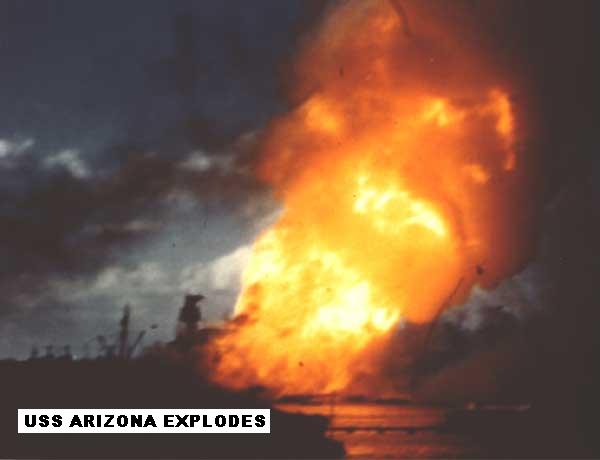
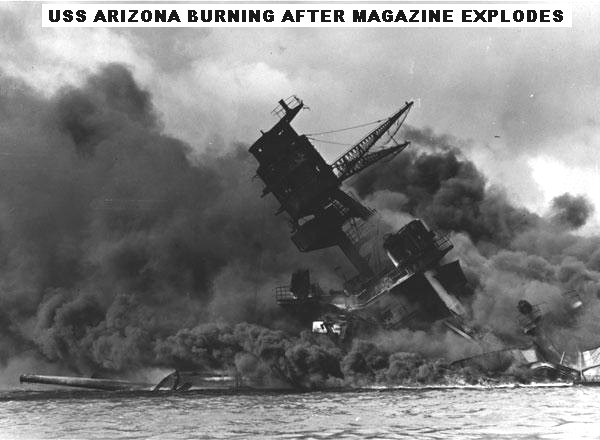
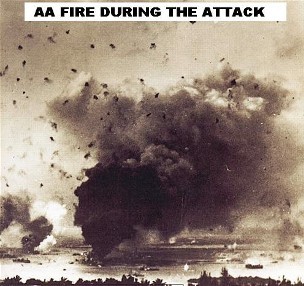


There was no ship movement in the harbor during this phase. The destroyer HELM opened fire on a submarine just outside the harbor entrance at 8:19, but no hits were observed.
PHASE II
This phase has been called a lull only by comparison. Attacking aircraft were over the harbor continuously, but attacks were sporadic. During this phase, an estimated 15 dive bombers participated in five attacks on ships the Navy Yard, the battleships MARYLAND, OKLAHOMA, NEVADA, PENNSYLVANIA, various light cruisers and destroyers.
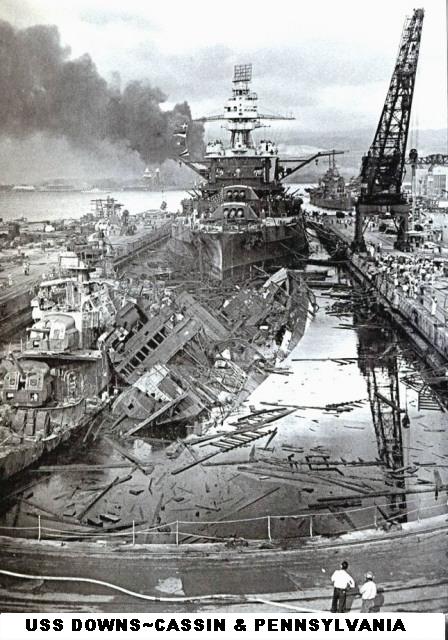
There were still very little ship movement during this phase of the attack. The destroyer MONAGHAN, moving toward the harbor entrance, sighted a submarine west of Ford Island being fired on by the CURTISS and TANGIER. The MONAGHAN rammed the sub at 8:43 and dropped depth charges on her. The CURTISS previously had scored two hits on her conning tower. The submarine later was salvaged for inspection and disposal. The MONAGHAN then proceeded to sea. At the same time the MONAGHAN got underway, the destroyer HENLEY got underway and followed the MONAGHAN to sea.
PHASE III
Phase II ended with the appearance of eight groups of high altitude bombers which crossed and re-crossed the harbor inflicting severe damage. Some of the bombs were converted 15 or 16 inch shells.
It was during this attack that the PENNSYLVANIA was hit by a heavy bomb which detonated amidships, causing a fire that was extinguished with some difficulty. The CALIFORNIA was hit by a 15 inch shell equipped with tail vanes which penetrated to the second deck and exploded.
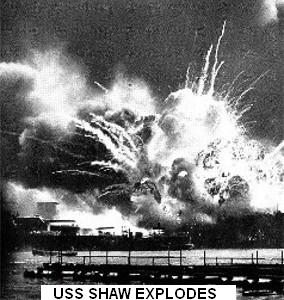
An estimated 30 horizontal bombers and 18 dive bombers participated in this phase. The second group of these is considered to be the one which inflicted heavy damage to the NEVADA, then steaming down the south channel, and to the SHAW, CASS1N and DOWNS, all three of which were set afire. A dive bomber also dropped one bomb on the CURTISS which detonated on the main deck killing 20 and wounding 58. The CURTISS destroyed one dive bomber which was pulling out of a dive over Ford Island.

There was considerable ship movement in the harbor during this phase. The NEVADA cleared her berth at 8:40 without assistance and steamed toward the harbor entrance. Dive bombers attacked the ship, registering several hits. Although her bridge and Fore structure were afire, she continued to fight effectively until 9:10 when, when she was trying to turn in the channel, she ran aground at Waipio Point.
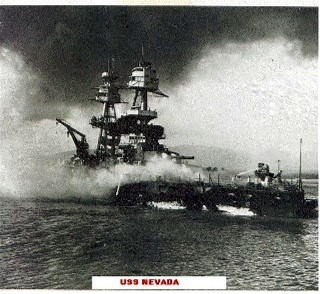
The repair ship VESTAL got underway at 8:40, unassisted and cleared the burning ARIZONA. She anchored Northeast of Ford Island at 9:10. Soon after, tugs began moving the OGALA to a position behind the HELENA at 1010 dock She was secured at 9: 00 a. m. but capsized shortly afterward. The oiler NEOSHO cleared her berth in Battleship Row, astern of the CALIFORNIA, at 8:42 and backed to Merry Point to reduce fire hazard to her cargo and to clear the way for the MARYLAND to sortie.
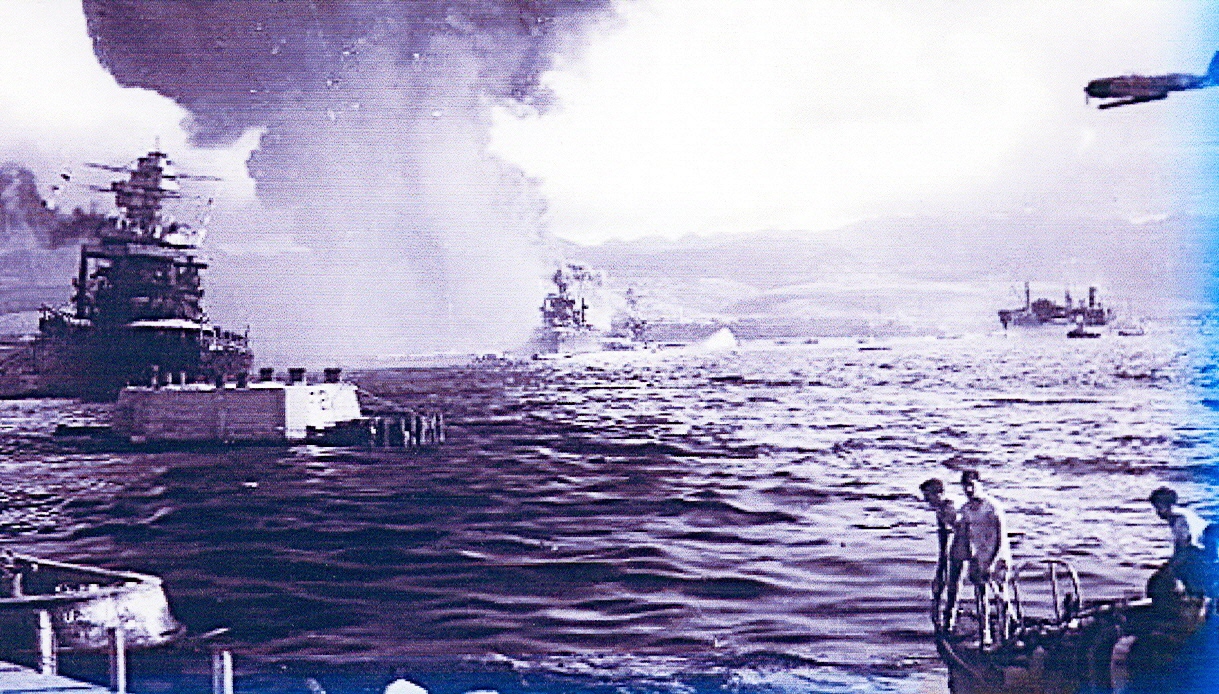
PHASE IV
During this phase 27 dive bombers conducted nine strafing attacks throughout the harbor.
COMPLETION OF THE ATTACK
By 9:45, all enemy planes had left the area. The Japanese task force returned to Japan without being contacted by any American units.
In Pearl Harbor, 18 warships either had been sunk or seriously damaged. The first Battleship damaged in the attack to return to action from the mainland was the MARYLAND.
CASUALTIES
2,408 KILLED - 1,178 WOUNDED = 3,586 TOTAL
NOTE:Many more were known to have received wounds from shrapnel and other flying debris that didn't receive hospitalization in the the already overcrowded medical facilities and no records were kept of their treatment.
AWARDS FOR HEROISM ON DECEMBER 7, 1941
MEDAL OF HONOR = 15
NAVY CROSS = 51
SILVER STAR = 53
NAVY AND MARINE CORPS MEDAL = 4
DISTINGUISHED FLYING CROSS = 1
DISTINGUISHED SERVICE CROSS = 4
DISTINGUISHED SERVICE MEDAL = 1
BRONZE STAR = 3
THE ARIZONA MEMORIAL IS FOR THOSE WHO WERE KILLED DURING
THE SURPRISE JAPANESE ATTACK ON PEARL HARBOR, DECEMBER 7,1941.